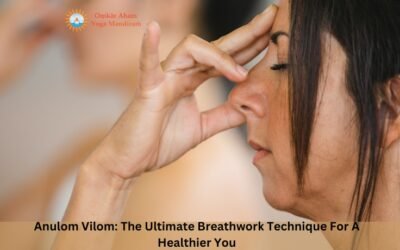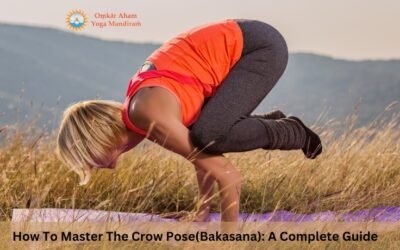Chakrasana or Urdhva Dhanurasana — also known as Full-Wheel Pose or Upward Bow Pose — is a backbend that expands the torso, strengthens the legs, stomach, and arms, and activates the entire body.
As a cardio exercise, this posture causes the brain to release sorrow and despair. It is named after the Sanskrit terms chakra, which means wheel, and asana means pose.
Oh, how wonderful Urdhva Dhanurasana is. As the arms and legs press firmly into the ground, the spine bends into a deep, uniform arch. It’s stunning, inspirational, and, well, it’s everywhere. You’re likely to experience the pose known as Upward Bow or Wheel Pose in practically any ancient yoga class during any time of day.
Steps By Step Instructions To Perform Chakrasana
- To begin, take a comfortable position on your back.
- Reduce the angle of your knees so that your feet are flat on the floor in a parallel position parallel to the line of your sitting bones, approximately a foot away from your hips. The feet should be fixed firmly on the ground.
- Put your hands on the floor directly above your shoulders, with your fingers pointing toward your shoulder blades.
- Compress into your hands and elevate your upper body above the mat, allowing the top of your skull to stay softly on the surface as you do so.
- Engage the upper thighs of your legs by pressing into your feet and raising your legs, hips, and belly off the mat.
- Increase the pressure on your feet by shifting more of your body weight into your hands. Your lower spine will be guarded as a consequence of this.
- Keep pushing forcefully into the mat to preserve balance and durability in your forearms and shoulders.
- Allowing your head to remain relaxed will help to prevent tension on your neck.
- Take 5-10 deep breaths and hold for 5-10 seconds.
- Return your arms and legs to their original positions on the mat and drop your backbone back onto it vertebrae by vertebrae to finish the stance.
Precautions And Safety Measures For Wheel Pose Or Urdhva Dhanurasana
- For people who suffer from lower back pain, it is recommended that they avoid this posture or adopt another variation, such as bridge pose or Cobra Pose, as an alternative.
- If you have a wrist injury, it can cause it even worse when you wear some wrist guards or do anything else that is more comfortable.
- When someone has neck pain or damage, it is essential that the neck is not curved but just kept upright in the direction of the vertebrae, and the emphasis is on the expansion of the chest.
- To reduce lower back tension while performing Chakrasana, ensure that your objective is to bow back from the upper chest and remain the abdominal muscles involved.
Advantages Of Chakrasana Or Wheel Pose
- It is good for arm, leg, and spine flexibility to do chakrasana.
- It helps in boosting breathing and enhances aerobic capacity by widening the chest region.
- For the goal of strengthening vertebral elasticity, people actively exercise this pose.
- Movements for thighs and gluteus muscles as well as column flexors and arm muscles.
- The quadriceps, iliopsoas, diaphragm muscles, latissimus dorsi and pectorals are all lengthened as a result of this exercise.
- It aids in the elimination of abdominal and leg fats.
- This results in an increased blood stream towards the head.
Preparatory Yoga Poses For Chakrasana
To start Chakrasana for beginners can result in painful muscles of the whole body. Thus, to avoid this situation, you can start doing some asanas, which make you relieve and prevent body pain.
King Arthur’s Posture and Bridge position are two primary poses to do before performing the Chakrasana. As both of these help, you release stress from the thighs and pelvic muscles.
King Arthur’s Pose
King Arthur’s Pose will extend your thighs. Place your sticky mat against a wall, folded in quarters. With your back to the wall, kneel and stretch your right thigh (foot pointed) up the wall.
Lean with your left knee precisely over your ankle, two to three feet forth with your left foot. Put your hands on your hips and look at your pelvis angle.
Your hips will likely bend forward to avoid extending your thighs. Instead, elevate the front of your hips and stretch your spine and buttocks toward the floor to promote alignment and openness.
As you push upwards into your belly core, bend your front leg further. If you want a true challenge, lean your right foot against the wall. This will increase the severity of your thigh stretch.
Setu Bandha Sarvangasana Or Bridge Pose
Take Setu Bandha Sarvangasana, or Bridge Pose, to expand the whole front of your thighs and hips.
Begin with lying back, knees bent, and feet hip-width apart—feet near but not touching your hips; arms straight to the body. Ensure your feet are aligned, and your heels are facing directly in front.
Begin by softly pushing your lower spine into the ground, curling your buttocks upward. Start by pulling your hips away from the floor—wrap your spine following the vertebra, extending your tailbone toward your knees. Curl your shoulders in. Merge your fingers or grasp the tacky mat’s exterior borders and burrow into it with your arms.
Conclusion
We discussed all the essential aspects of this Urdhva Dhanurasana pose. But usually, it is recommended for all beginners to take safety measures and precautions while performing it.
You can learn and gain knowledge on Chakrasana under the proper guidance of professional trainers. You can join our 500 yoga teacher training Rishikesh course for a better experience. For more details visit us at:
Call/WhatsApp: +91-9997744876
Mail us at: info@yogateachertrainingschool.com




